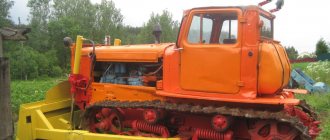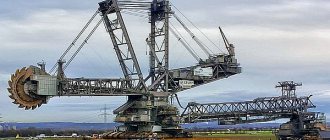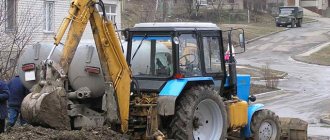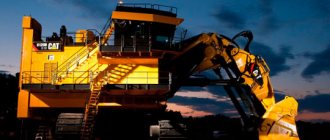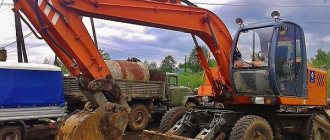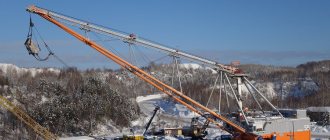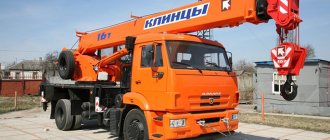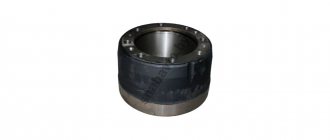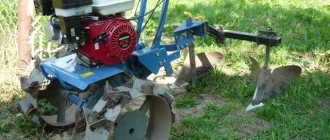| This article or section relies on sources affiliated with the subject of the article or other interested party. This may raise doubts about the neutrality and verifiability of the information presented. Such sources also do not show the significance of the subject of the article. The article could be improved by using independent secondary sources instead of affiliated ones. (October 20, 2015) |
| JSC "Tver Excavator" | |
| Type | closed joint stock company |
| Base | 1943 |
| Location | Russia Russia: Tver |
| Key figures | Managing Director: Chekalin Vladimir Aleksandrovich |
| Industry | mechanical engineering |
| Products | excavators; loaders |
| Number of employees | 626 people (2016) |
| Parent company | RM-Terex |
| Auditor | Rosexpertiza LLC |
| Website | www.tvexc.ru |
| Tver excavator on Wikimedia Commons | |
Closed Joint Stock Company "Tver Excavator"
- an enterprise specializing in the production of wheeled and tracked excavators, as well as forklifts. Located in the city of Tver, Russia.
Story
| This section is excessively long or contains unimportant details. If you do not agree with this, please show in the text the materiality of the material presented. Otherwise, the section may be deleted. Details may be on the talk page. |
Pre-war and war period
The official date of establishment of the plant is October 1943[1]. But its history began earlier: in 1938, the People's Commissariat for Construction decided to build an excavator repair plant in the city of Kalinin. In 1939, excavation work began: the foundations of future workshops were laid, and a water supply system was laid. In 1940-1941, the construction of the first workshops began: woodworking, forging and tooling, assembly, repair, mechanical No. 1 and steel foundry.
With the outbreak of the Great Patriotic War, construction of the plant was interrupted and mothballed until January 1943. Then the State Defense Committee gave the order to the People's Commissariat of Construction of the USSR: to continue the work interrupted by the war on the construction of machine-building enterprises, including the Kalinin Excavator Plant, then called KRMZ and part of the People's Commissariat of Construction.
In January 1943, the directorate of the enterprise under construction was created. Vasily Dmitrievich Reshetko was appointed the first director of KRMZ.
The first equipment was transferred free of charge from the balance of Tsentrostroymekhanizatsiya and from the Glavstroymekhanizatsiya plant (Saratov). In October 1943, the plant produced its first products and was already listed among the operating enterprises. The area of its industrial premises is 250 square meters, there are 5 machines, and 46 workers. There were not enough premises, people worked in the open air and in army tents.
The first products of the plant were consumer goods: rakes and buckets. The plant carried out installation work and repair of machines. The working day during the war lasted from 8 am to 7 pm. From 8 to 10 am, all factory workers worked unloading firewood and peat from barges, and then carried out their main duties.
In 1945, the plant was first set a yearly plan for saw shafts, Bako keys, mast lifts, and spare parts for construction machinery. This year, the first experimental units for excavators were manufactured. The mechanical, mechanical repair and assembly shops were put into operation, the forging, tool and woodworking shops began to operate.
Post-war years
In 1946, the Moscow branch of Promstroyproekt developed a design assignment for the reconstruction of KRMZ for the production of crawler excavators. In addition, the plant was still supposed to produce saw shafts and multi-story lifts. The company already employed 392 people. On December 14, 1946, the Ministry of Construction and Dormash approved the design assignment for the reconstruction of the plant: for the production of 120 crawler excavators of the “D-107” type with a bucket capacity of 0.5 cubic meters per year.
In February 1947, a new manager was appointed - Pyotr Potapovich Dolbanov, who led the enterprise until 1970. During this time, the plant not only acquired the profile, but also the fame of one of the largest industrial enterprises in the country.
In 1946-1948, the plant produced components and spare parts for excavators in cooperation with the Leningrad, Kostroma and Dmitrov excavator plants. Cooperation developed for the supply of metal structures and machined parts for the Kostroma, Kyiv, Tashkent, Dmitrov and Leningrad plants.
In 1948, KRMZ "Excavator" was renamed the Kalinin Excavator Plant of the Ministry of Construction and Road Engineering (KEZ). A mechanical assembly shop with an area of 5362 m² was put into operation. At the beginning of December 1949, a prototype of a universal pneumatic wheeled excavator with a rope suspension boom E-255 was manufactured, serial production of which began in October 1950. The E-255 had a bucket with a capacity of 0.25 cubic meters. m., highest travel speed -12.1 km/h, weight - 12 tons, productivity 60 cubic meters. m. per hour. It was the country's first pneumatic wheeled excavator, which differed from its tracked counterparts in its high speeds of movement and productivity. By the end of the year, 26 excavators were produced. Three years later, the plant for the first time shipped 34 excavators for export, mainly to socialist countries.
In 1951, 153 excavators were manufactured. Serial production of lattice booms, grab buckets and draglines has been mastered. The plant began reconstruction of the tool shop with thermal separation. The number of employees at the end of the year was 1,181 people.
In 1953, a prototype of the modernized E-253 excavator with a 0.35 cubic meter bucket was manufactured. m. New forms of production organization are being introduced - closed-loop production lines. Working conditions are improving: the plant has been completely switched to hot water heating, and bathrooms have been opened in the workshops. A kindergarten for 75 children was built and put into operation, and 1,100 m² of housing was put into operation. In October 1954, the 1000th E-255 excavator was produced. The design assignment for the reconstruction of the plant was approved to produce 2,000 excavators per year.
In 1957, the plant completely switched to the production of excavators of the new E-302 model on the basis of broad cooperation and specialization with the Leningrad Excavator Plant. 600 excavators were produced per year. In 1958, the plant designed, manufactured, tested and prepared for serial production the E-305 excavator - on a motor vehicle. It began to be produced serially in 1959. In 1959, factory tests were carried out on a prototype of the E-304 excavator on a widened crawler track; it went into production in 1960.[2]
1960s
In February 1960, on the basis of an order from the Council of Economic Affairs of the Kalinin Economic Administrative Region, a neighboring machine-building plant merged with an excavator plant and transferred to it the production of MD-54-4 motor locomotives and spare parts for them.
1961 Factory and state tests of prototypes of new excavators on pneumatic wheels of the E-402 model and crawler type E-403 have passed. For their successful work, the plant’s staff was included in the Book of Labor Glory of the region.
In 1962, the plant was awarded a 1st degree Diploma from the USSR Exhibition of Economic Achievements for the creation and mass production of the E-304 excavator. In 1963, a pioneer camp with 160 places was put into operation. In 1965, serious work was carried out to modernize and launch a series of E-302A, E-304A, E-305A excavators, and to test the E-4022S excavator in the Far North. In March 1967, the first issue was published. In 1968, working drawings were developed and the first industrial batch of excavators in the northern version E-302 BS was manufactured. In 1969, a prototype of a leveling excavator with a telescopic boom with a hydraulic drive on a pneumatic wheel was manufactured.[2]
1970s
A new stage in the development of KES began in the 70s: it was associated with the creation of hydraulic excavators and accelerating the pace of the first reconstruction of the plant. In 1970, Pavel Borisovich Pankratov was appointed director. In the same year, acceptance tests were carried out on a prototype excavator-planner EO-3322. Its main parameters: bucket with a capacity of 0.4 m³, telescopic boom, hydraulic drive, pneumatic wheel travel.
In the shortest possible time, in 1971, the construction of a block of auxiliary workshops completed the first reconstruction of the plant. The reconstruction made it possible to increase the production volume of excavators from 851 to 2300 per year. Serial production of hydraulic excavators has begun. Much work has been done to create and master the production of new models, improve designs and improve the economic performance of mass-produced machines. The design department developed a project for the EO-3521 excavator and produced installation series for the EO-3322 excavator with bucket capacities of 0.5 and 0.4 m³. A prototype of the modernized EO-302B excavator was manufactured. New technical processes have been mastered in the steel foundry, iron foundry and thermal forging shops, as well as in the galvanizing section.
In 1974, for the creation and development of serial production of hydraulic excavators EO-3322A, the plant was awarded the VDNKh Diploma of the second degree. In 1978, the EO-3322B excavator was awarded the State Quality Mark.[3]
1980s
In 1981. Excavators with hydraulic drive became the main series and the calling card of the plant for many years. Equipment with the KEZ brand - Kalinin Excavator Plant - was exported to dozens of countries around the world. In March 1981, the 50,000th excavator was produced, and the plant was awarded the Order of the Red Banner of Labor for equipping the country's national economy with high-performance equipment.[3]
1990s
In 1991, the plant mastered its own production of bridges, abandoning expensive purchases in Poland. In August 1992, at a conference of the workforce, a decision was made to transform the rental enterprise "TEZ" into a joint-stock company "TEZ". This became a key moment in the privatization of the plant’s property by a collective of workers. The transition period until the complete buyout of the enterprise was approximately a year. In 1993, 4 thousand excavators were manufactured - a record number.
The severance of foreign economic ties continues. Therefore, the team is faced with the task of developing its own production of hydraulics: hydraulic cylinders, hydraulic distributors, hydraulic locks. Marketing focuses on expanding the range of equipment and developing new models.
The mid-nineties were extremely difficult for the plant, as well as for industry throughout the country. The company's export contracts largely helped to successfully overcome this period.[3]
Modern history
On August 15, 2000, Tver Excavator OJSC was founded. In 2001, the plant became part of the RusPromAvto holding.
Activity
| This section is excessively long or contains unimportant details. If you do not agree with this, please show in the text the materiality of the material presented. Otherwise, the section may be deleted. Details may be on the talk page. |
Main activities
| This section is excessively long or contains unimportant details. If you do not agree with this, please show in the text the materiality of the material presented. Otherwise, the section may be deleted. Details may be on the talk page. |
- development, production and sale of a wide range of hydraulic pneumatic wheeled and tracked excavators, both for civilian use and for the Ministry of Emergency Situations and the Ministry of Defense; production of machine kits for tracked and wheeled excavators for organizing the assembly of machines in the Republic of Belarus; development and production of forklifts
- development, production and sale of replaceable types of work equipment;
- production and sale of spare parts;
- warranty and service maintenance of manufactured products;
- provision of paid services to the population;
- investment activities;
- foreign economic activity;
- other types of activities not prohibited by current legislation.
In 2009, TVEX OJSC operated in two market segments:
- Hydraulic excavator segment.
- Replacement work equipment segment.
Products
| This section is excessively long or contains unimportant details. If you do not agree with this, please show in the text the materiality of the material presented. Otherwise, the section may be deleted. Details may be on the talk page. |
The main type of products manufactured at JSC TVEX are hydraulic single-bucket excavators with pneumatic wheels and crawler tracks. In 2009, TVEX OJSC offered on the market 12 models of various equipment and 120 of their modifications:
- wheeled excavators of the 2nd and 3rd and 4th size groups EK8, EK12, EK14, EK18, EK20, ET14, ET16, ET18, ET20 and ET26 with a bucket volume from 0.32 m³ for EK8 to 1.25 m³ for ET26;
- forklifts with a lifting capacity of 5 and 7 tons;
- modifications of the loading excavator EK-18-45, equipped with an enlarged support contour, a rising parallelogram-type cabin and scrap working equipment with a five-jaw loading grab;
- special machines: excavator on a URAL automobile chassis;
To expand the capabilities of the equipment, instead of the standard backhoe bucket, the plant produces and can use the following as replacement working parts of excavators: MG-300 hydraulic hammer, profile buckets and smaller-volume buckets, ripper tooth, digging and loading grabs, hydraulic shears, concrete breaker, etc. d.
Complete set of manufactured equipment
| This section is excessively long or contains unimportant details. If you do not agree with this, please show in the text the materiality of the material presented. Otherwise, the section may be deleted. Details may be on the talk page. |
Engines from the Minsk Motor Plant and Tierll engines from Perkins were used as the power unit for the plant's equipment; it is possible to install DEUTZ engines. Hydraulic pumps and hydraulic motors are from Bosch-Rexroth and Yekaterinburg; hydraulic distributor, pneumatic hydraulic accumulator, hydraulic cylinders, central manifold, turning mechanism, gearbox, axles are of our own production. Servo control units are of our own production and produced in Yekaterinburg.
In 2009, 80% of the machines in the total production volume were equipped with domestic hydraulics (PSM) and engines Minsk Motor Plant Open Joint Stock Company; 12% of the machines were equipped with imported hydraulics and engines Minsk Motor Plant Open Joint Stock Company and 8% of the machines were equipped with Bosch-Rexroth hydraulics and Perkins engines.
In 2009, new modifications of excavators were released, namely: excavator EK-14-60-60 (excavator with a Perkins engine, operating pressure 32 MPa, Bosch-Rexroth hydraulics assembled according to the LUDV hydraulic scheme), EK20 (excavator with a YaMZ-236G5 engine, ZF transmission), ET20 (excavator with YaMZ-236G5 engine and tracked vehicle from ET18), ET26 (excavator with YaMZ-236G5 engine).
The assembly of crawler excavators of the 4th size group ET26 with a bucket volume of up to 1.25 m³ was transferred from the 4th quarter of 2009 from EZ Kovrovets LLC to TVEX OJSC. JSC TVEX produces machine kits for assembly in the Republic of Belarus, which consist of a rotating platform, a cabin, a gearbox and working equipment (handle with bucket, boom, lifting hydraulic cylinders). The Svyatovit and Diapal enterprises assembled excavators.
As part of joint work with the enterprise EZ Kovrovets LLC, to meet consumer demand and to expand the model range, new models of crawler excavators weighing 27, 30 and 40 tons have been developed, where the bucket volume has been increased to 2 m³.[4]
Wheeled excavator - types and types
A wheeled excavator is a specialized piece of equipment that is a type of earthmoving machine and has a bucket. A wheeled excavator is a securely fixed frame, which is connected to a pneumatic wheel running device. It is on the basis of this device that the rotary platform of the excavator is based. The design of the special equipment also provides for the presence of special outriggers, which minimize the risk of the machine slipping even when the bucket is fully loaded. Outriggers make the wheeled model absolutely stable and safe to use. Advantages of a wheeled excavator: - speed. A wheeled excavator can reach up to 35 km/h, and this impressive figure is eight times the speed of tracked vehicles; — the equipment does not cause any damage to the road thanks to the wheels shod with tires, and therefore the wheeled excavator can be used within the city; - high power. Wheeled excavators can work on soils up to the 4th category of complexity inclusive, which implies the use of equipment for serious excavation work: when creating the foundation for a future construction site or when excavating a pit for pouring a foundation; — excellent handling and visibility. To perform excavation work, especially within the city, a wheeled excavator has precision when moving soil. Visibility allows wheeled excavators to move between various objects without creating congestion even on small city streets; — the special equipment has a really small turning radius of the platform, which makes it possible to use a wheeled excavator close to buildings.
Our equipment Wheeled excavators from are more than a dozen machines on tractor, pneumatic or automobile chassis that will become your indispensable assistants at any stage of construction. The special equipment is equipped with a powerful lifting mechanism, a direct or reverse bucket (based on customer requirements), hydraulic hammers, hydraulic shears, a grab, a ripper and other additional equipment. Our wheeled excavators will be useful to you for: - digging pits and digging trenches for laying communications; — removing asphalt; — cleaning ditches and moving construction waste; - work as a lifting mechanism. Experienced drivers, the newest cars, affordable prices for renting wheeled excavators, issuance of all accompanying documents - all this is available in!
